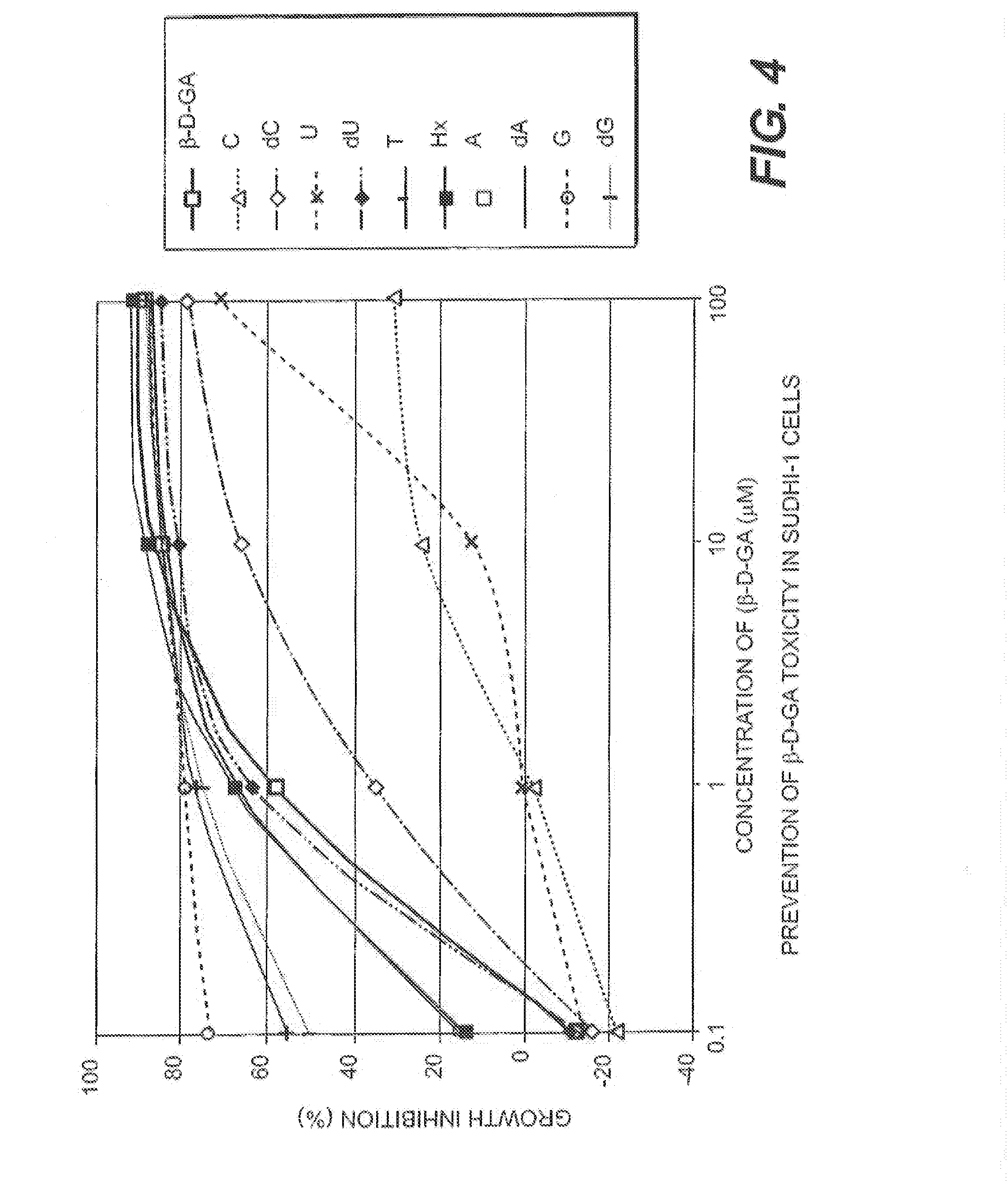Modified nucleosides for the treatment of viral infections and abnormal cellular proliferation
a technology of nucleosides and viral infections, applied in the direction of drug compositions, immunological disorders, metabolism disorders, etc., can solve the problem of quite unpredictable epidemics
- Summary
- Abstract
- Description
- Claims
- Application Information
AI Technical Summary
Benefits of technology
Problems solved by technology
Method used
Image
Examples
example 1
1-(2,5-Di-O-acetyl-3-bromo-3-deoxy-β-D-xylofuranosyl)-N4-acetylcytosine (2, R═H)
[0393]To a suspension of N4-acetylcytidine (5.7 g, 0.02 mol) in acetonitrile (300 mL) is added acetyl bromide (15 mL, 0.2 mol) over 30 minutes under reflux. The mixture is refluxed for 4 hours, and then concentrated in vacuo to dryness. The residue is dissolved in methylene chloride (150 mL) and washed with water (150 mL). The organic layer is dried (Na2SO4), evaporated, and the residue crystallized from ethanol to give 1-(2,5-Di-O-acetyl-3-bromo-3-deoxy-β-D-xylofuranosyl)-N4-acetylcytosine (2, R═H, 3.4 g, 40%), mp 179-180° C. NMR (CDCl3) δ: 10.2 (bs, 1H, NHAc), 8.1 (d, 1H, H-6, J5,6=7.5 Hz), 7.5 (d, 1H, H-5, J5,6=7.5 Hz), 6.0 (d, 1H, H-1′, J1′,2′1′,2′2′,3′=0 Hz), 4.2-4.7 (m, 4H, H-3′,4′,5′,5″), 2.0-2.4 (3s, 9H, 3Ac).
[0394]In a similar manner but using the corresponding N-acylated cytidine, the following nucleosides and their L-counterparts are prepared:[0395]1-(2,5-Di-O-acetyl-3-bromo-3-deoxy-β-D-xylofu...
example 2
1-(2,5-Di-O-acetyl-3-deoxy-β-D-erythropentofuranosyl)-N4-acetylcytosine
[0445]1-(2,5-Di-O-acetyl-3-bromo-3-deoxy-β-D-xylofuranosyl)-N4-acetylcytosine (2.15 g, 5 mmol) in 50% aqueous methanol (100 mL) is hydrogenated in a Parr apparatus in the presence of powdered calcium carbonate (1 g) and Pd—BaSO4 catalyst (0.5 g) at the initial pressure of 45 psi. The catalyst is removed by filtration, and the filtrate is concentrated in vacuo. The residue is crystallized from ethanol to give 1-(2,5-di-O-acetyl-3-deoxy-β-D-erythropentofuranosyl)-N4-acetylcytosine (3, R═H, 1.06 g, 60%), mp 174-177° C. 1H NMR (CDCl3) δ: 10.30 (bs, 1H, NHAc), 8.05 (d, 1H, H-6, J5,6=7.5 Hz), 7.43 (d, 1H, H-5, J5,6=7.5 Hz), 5.90 (d, 1H, H-1′, J1′,2′=1.0 Hz), 5.46 (m, 1H, H-2′), 4.30-4.80 (3H, m, H-4′,5′,5″), 2.10, 2.27 (2s, 9H, 3Ac), 1.60-2.00 (m, 2H, H-3′,3″).
[0446]In a similar manner but using the corresponding 3′-bromo-xylo nucleosides, the following nucleosides and their L-counterparts are prepared:[0447]1-(2,5-Di-...
example 3
1-(3-Bromo-3-deoxy-β-D-xylofuranosyl)cytosine (3, R═H)
[0461]1-(2,5-Di-O-acetyl-3-bromo-3-deoxy-β-D-xylofuranosyl)-N4-acetylcytosine (4.31 g, 0.01 mol) is treated with saturated methanolic ammonia (100 mL) at 0° C. for 30 minutes, and then concentrated in vacuo below 35° C. The residue is crystallized from methanol to give 1-(3-bromo-3-deoxy-β-D-xylofuranosyl)cytosine (3, R═H). The UV and 1H NMR (D2O) are consistent with the xylo-structure
[0462]In a similar manner but using the corresponding N-acylated cytidines, the following nucleosides and their L-counterparts are prepared:[0463]1-(3-Bromo-3-deoxy-β-D-xylofuranosyl)-5-fluorocytosine,[0464]1-(3-Bromo-3-deoxy-β-D-xylofuranosyl)-5-chlororocytosine,[0465]1-(3-Bromo-3-deoxy-β-D-xylofuranosyl)-5-bromocytosine,[0466]1-(3-Bromo-3-deoxy-β-D-xylofuranosyl)-5-iodocytosine,[0467]1-(3-Bromo-3-deoxy-β-D-xylofuranosyl)-5-methylcytosine,[0468]1-(3-Bromo-3-deoxy-β-D-xylofuranosyl)-5-ethylcytosine,[0469]1-(3-Bromo-3-deoxy-β-D-xylofuranosyl)-5-n-pro...
PUM
| Property | Measurement | Unit |
|---|---|---|
| time | aaaaa | aaaaa |
| time | aaaaa | aaaaa |
| temperature | aaaaa | aaaaa |
Abstract
Description
Claims
Application Information
 Login to View More
Login to View More - R&D
- Intellectual Property
- Life Sciences
- Materials
- Tech Scout
- Unparalleled Data Quality
- Higher Quality Content
- 60% Fewer Hallucinations
Browse by: Latest US Patents, China's latest patents, Technical Efficacy Thesaurus, Application Domain, Technology Topic, Popular Technical Reports.
© 2025 PatSnap. All rights reserved.Legal|Privacy policy|Modern Slavery Act Transparency Statement|Sitemap|About US| Contact US: help@patsnap.com



